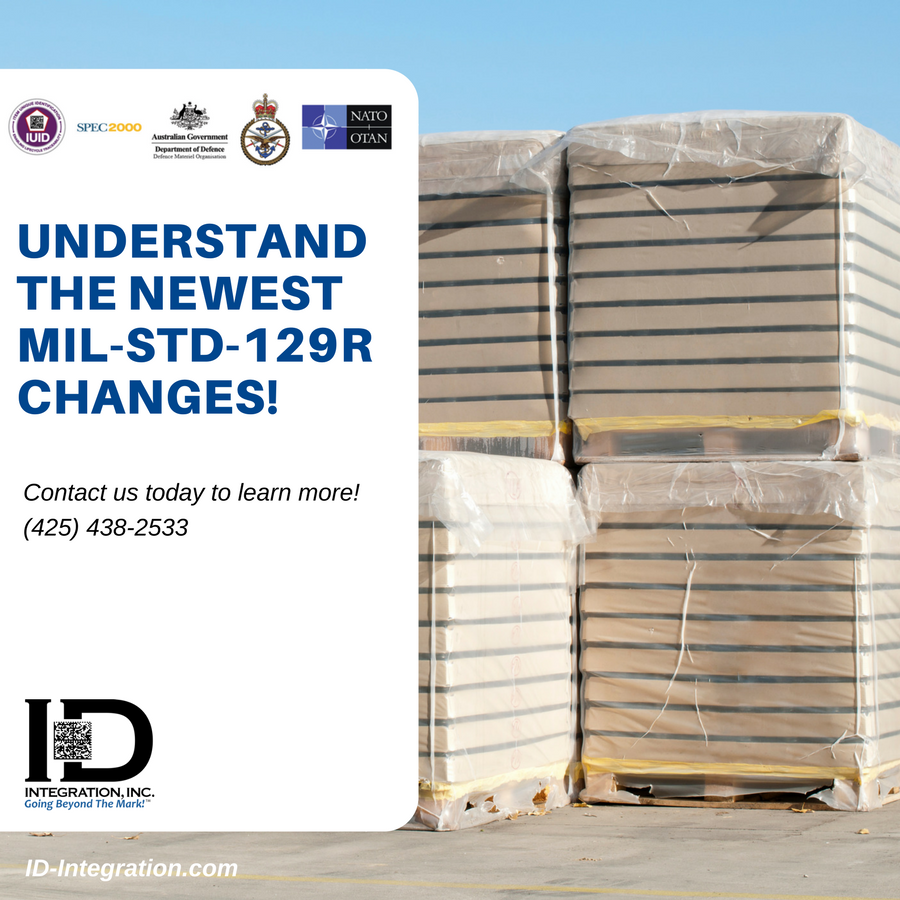MIL-STD-129 Marking and Labeling Requirements for Department of Defense (DoD) Shipments
The standard for container and shipment labeling of military equipment and supplies is the Department of Defense MIL-STD-129 requirement. It maintains uniformity of package labeling for transport. The purpose of this consistent identification of packages is for easy identification when it comes time to requisition for restocking.
How does this requirement differ from MIL-STD-130?
The MIL-STD-129 regulations apply to labeling shipments and containers, whereas the MIL-STD-130 standards are for marking individual units that are loaded within a carton or pallet.
How do you comply with MIL-STD-129?
As with MIL-STD-130, follow the label requirements and submit information to the DoD upon shipment using the Wide Area Workflow (WAWF) portal. All Item Unique Identifiers (UIIs) must be included on the labels of containers, which are defined as:
✓ Unit Container or Unit Pack—The smallest package that contains a part
✓ Intermediate Container—The outer packaging of a set of unit packs
✓ Exterior Container—The outermost packaging for a set of intermediate containers
When shipping parcels, each package with a shipping address label is an Exterior Container. When shipping pallets, each pallet is an Exterior Container.
All IUID information from MIL-STD-130 IUIDs must be noted on both intermediate and exterior containers. And keep in mind that label requirements differ for each level of packaging.

What’s required to comply with the newest change to the DOD’s packaging identification requirement: MIL-STD-129R?
Previous container labeling rules, dating back to 2007, began to move towards the trend of merging the packaging and shipping standard indicated in MIL-STD-129 with the individual item identification stipulated by MIL-STD-130. Mandatory 2D PDF417 barcodes with linear barcodes were required on outer containers.
The newest Military Shipment Label (MLS) requirement, MIL-STD-129R, was released in 2014. It adds an extra piece of required data on the label, a “Transportation Tracking Number” or TTN. IUIDs must still be encoded with PDF417 symbology on Unit and Intermediate labels, but the method for doing so is different. Now, each unit item must be encoded with an ISO 15434 Format 6 envelope. When more than five items are contained within the package, an additional list of barcoded serial numbers and IUIIs are needed.
RFID use, which was once optional, is now the default expectation for pallet and case shipments. Some items need additional labeling, such as munitions and explosives, which must include DoD compliant tags that indicate “hazards of electromagnetic radiation to ordinance” or HERO info.
With the additional information that is now necessary, it’s no wonder that MIL-STD-129R migrates away from the use of linear barcodes. Linear barcodes lack data identifiers that require the user of a barcode scanner to manually map and ID barcode data into a system. With MIL-STD-129R, the emphasis is on an increased need to identify serialized items with IUIDs.
The long data strings of linear bar codes no longer crowd labels with this most recent packaging change. Now, a single, 2-dimensional PDF417 barcode replaces the ten linear bar codes required for shipping parts with IUIDs.
These PDF417 barcodes take up more space than the 2D Data Matrix barcode, but this symbology allows for automated data systems to read all information about the contents of a shipment. PDF417 labels eliminate the need of additional human assistance—It is a complete data structure that includes identifiers and permits automated system recognition. This multi-use symbology has applications for RFID-driven materials as well as containers that roll down conveyer belts.
Scanning a shipping label that is compliant with MIL-STD-129 standards enables military staff to quickly import all individual IUIDs for products inside of a container by simply scanning the label on the outside of the container.
What should these marks look like? Where are these labels to be placed on unit packs, intermediate containers, and exterior containers? What is the bare minimum of data to be contained on these shipping labels?
This is where our DoD expertise here at ID Integration comes in. Labels for military shipments must be compliant for entry into the WAWF database, and these new MIL-STD-129R requirements add additional wrinkles to an already complex set of rules. Our specialists have the knowledge to guide you through the maze of what you’ll need for labeling, scanning, and validation hardware and software. Our BarCodeOS ® enabled scanners add intelligence to the barcode scanning process. They’ll quickly ensure that your PDF417 barcodes are good with a single auditory beep. Non-compliant syntax issues are indicated with 4 beeps.
We customize our recommendations so that you don’t end up purchasing systems that are unnecessary for compliance. Contact us today for a free consultation to get started: (425) 438-2533. We’re here to help you make sense of the most recent DoD packaging requirements.
